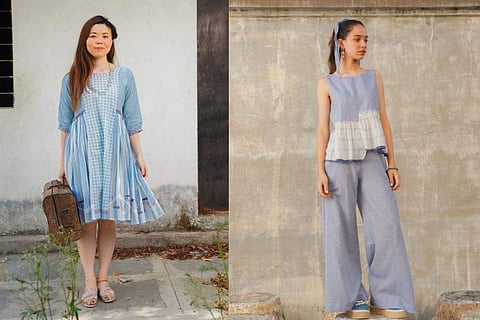
- LIFESTYLE
- FASHION
- FOOD
- ENTERTAINMENT
- EVENTS
- CULTURE
- VIDEOS
- WEB STORIES
- GALLERIES
- GADGETS
- CAR & BIKE
- SOCIETY
- TRAVEL
- NORTH EAST
- INDULGE CONNECT

A new player in the field of fashion, Hyderabad-based labe RaMa by budding designer Rajeswari Mavuri celebrates the cultural heritage of handwoven fabrics and melds slow fashion with everyday luxury. Taking anywhere between 7-48 hours to craft, RaMa’s Wanderlust range features timeless fabrics of Bengal - muslin, jamdani and khadi and pays tribute to the destinations each piece evokes. New York, for example, is a relaxed-fit jumpsuit that has 120-count fine fabric while Istanbul is a saffron and turmeric-toned top reflecting the warm, sunlit glow of the Turkish capital, and Berlin is an asymmetrical tunic with the same edginess that the city has. Closer to home, there’s Mount Abu top with tassels akin to Gujarat and Rajasthan’s flamboyant ethnic clothing.
Tell us all about the collection.
For the Wanderlust collection, based on the timeless fabrics of Bengal like muslin, jamdani and khadi, I went global and the range is as diverse as the world we live in. The colours go from vibrant and deep to calm and muted. The silhouettes go from jaunty and flaunty to understated and modest. The clothing is designed keeping a traveler in mind - it is practical and elegant, and comfortable enough to wear all day while walking in crowded markets or art museums, and each piece can be accessorized to dress up or down, depending on the occasion.
We have used the softest of Muslins (mul) cotton fabrics, and the finest cotton jamdani and khadi. The cuts are carefully thought too to suit women of all ages.
How has the journey for your label been so far and the learning process as a designer?
It’s like a roller coaster - it’s exhilarating at times and scary at times.
But the biggest and most meaningful lesson I’ve learned is that you have to stick to your idea, believe in yourself and be willing to take risks.
We’re barely a year old and we are still evolving, both in terms of design as well as operations. It is my goal to work with 2-3 rural weaving clusters each year. This year we worked with clusters in West Bengal and Andhra Pradesh and we are looking forward to more such experiences.
Wardrobe essentials for any woman?
A trouser that can be styled and paired in a thousand ways! You can pair it with a structured shirt for office wear or with a tank top to go to the beach! A dress that one can wear to work and then accessorize with a belt and jewellery to go straight to dinner or drinks with friends, and a basic but beautiful statement white shirt.
How difficult or easy is it to achieve Western silhouettes with indigenous fabric?
I suppose it depends on the fabric. Many of India’s handlooms were not really designed to be stitched but rather to be draped as saris or dhotis or maybe just hand-stitched. When you work with those kinds of fabrics, it can be quite challenging.
For the first two collections, where we worked with muslins and Jamdanis, we had to spend a lot of time experimenting because those fabrics are complex to stitch because of their fineness and flow. The process took several cuts and tries and iterations. The finest fabrics also present some design limitations in terms of silhouettes. Sometimes, I have used a mixture of Khadi and Muslin to get the silhouette I was looking for.
How much has the taste of the young generation changed when it comes to casual and RTW fashion?
One thing that concerns me is that youth fashion is becoming very homogeneous across the globe and we are losing a lot of local and cultural style and flavour. Young teens from India or the US or Japan dress pretty much the same. In India we still have local handlooms being preserved at least for occasion wear but even that is disappearing fast.
My other concern is that the younger generation is leaning towards cheap, fast fashion and trends. Despite being more environmentally aware and planet positive than the preceding generations, they still tend towards fast fashion.
Your upcoming collections?
My next two collections in 2023 will come out in the fall. The first one is Maya, made from the hand-block printed Kalamkari from Pedana in Andhra Pradesh. I found a group that still makes it the traditional way using 25 steps and all-natural dyes. For the silhouettes, I used the subtly erotic poems - Padams and Javallis - of the region. After Maya, we will release a collection of outerwear made from gorgeous, vintage Benarasi brocade saris.